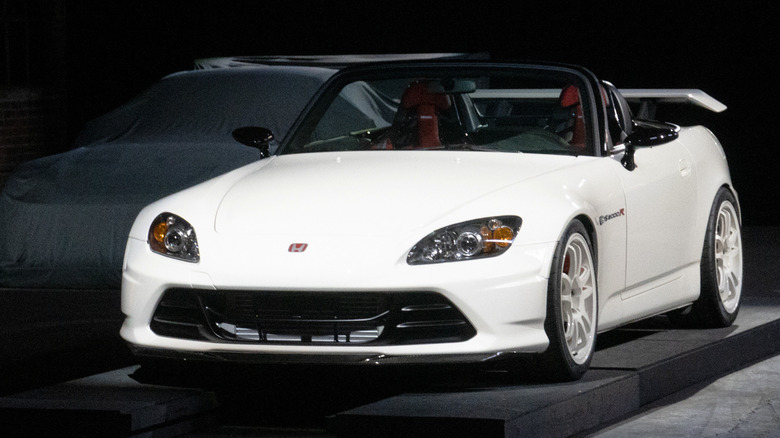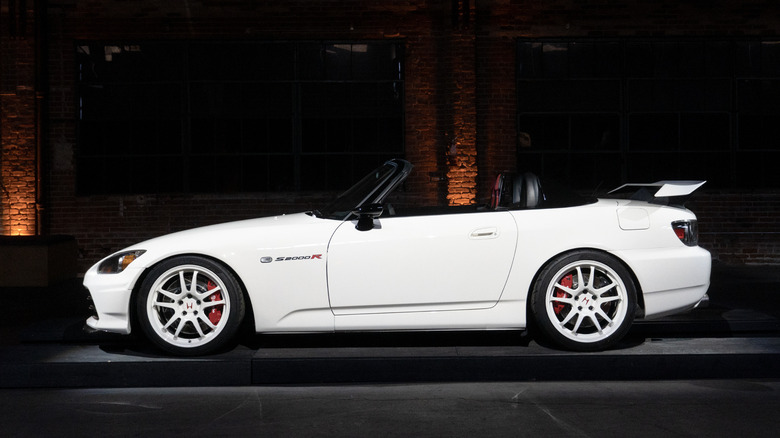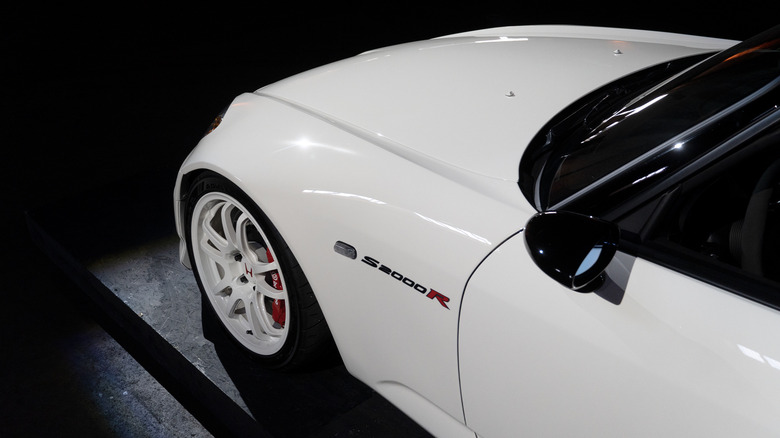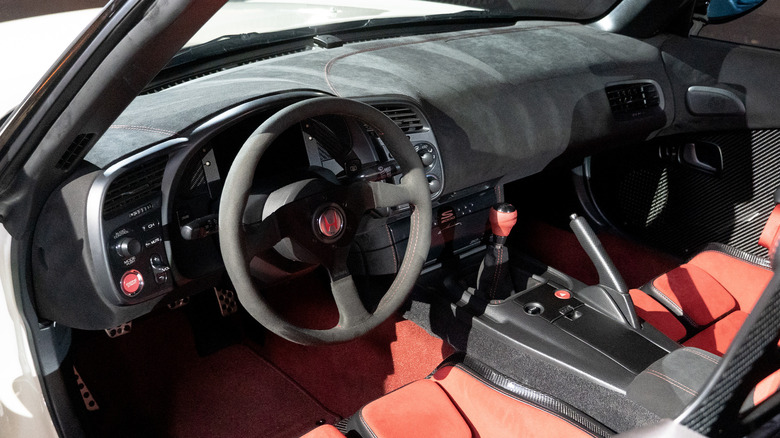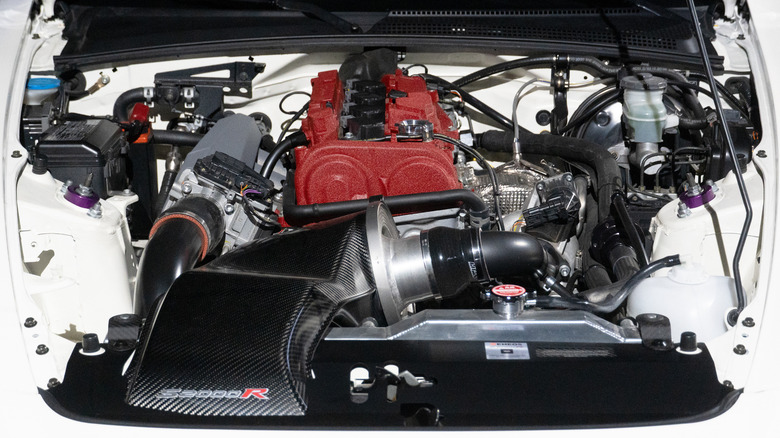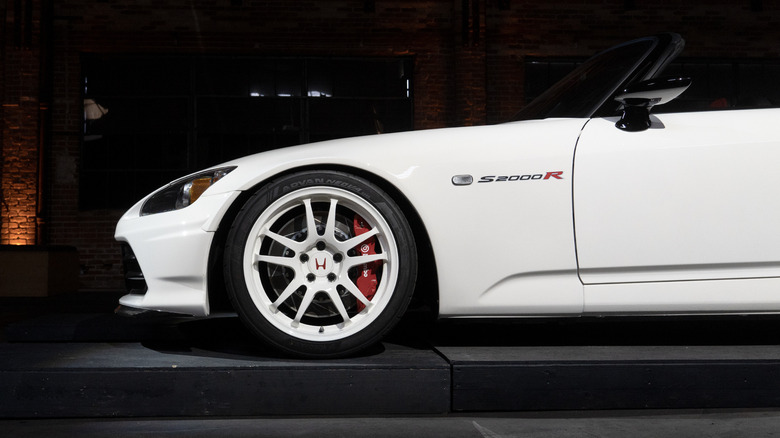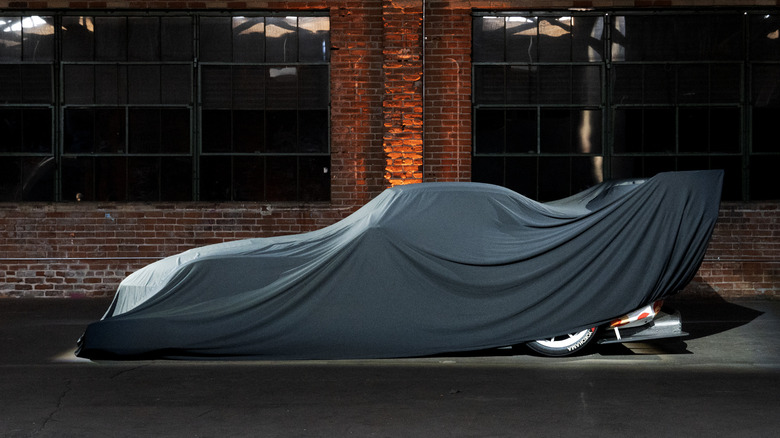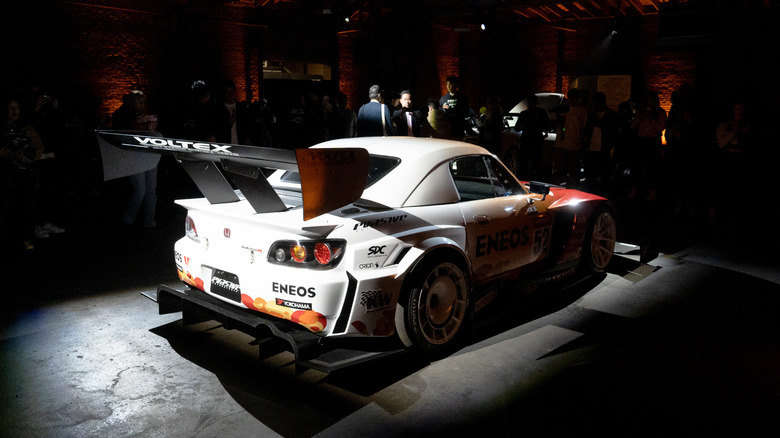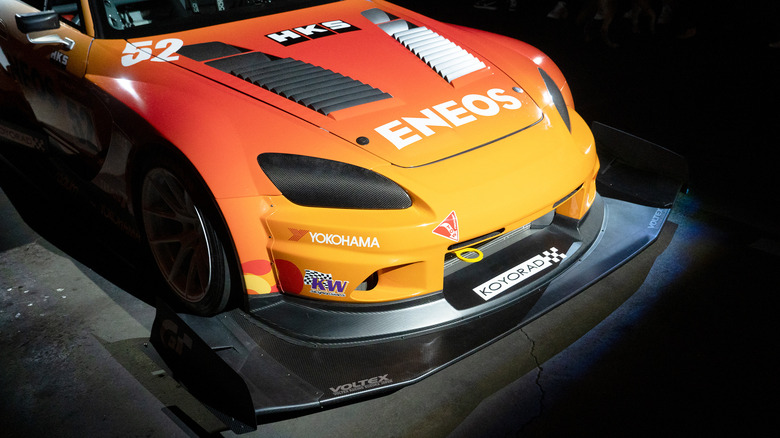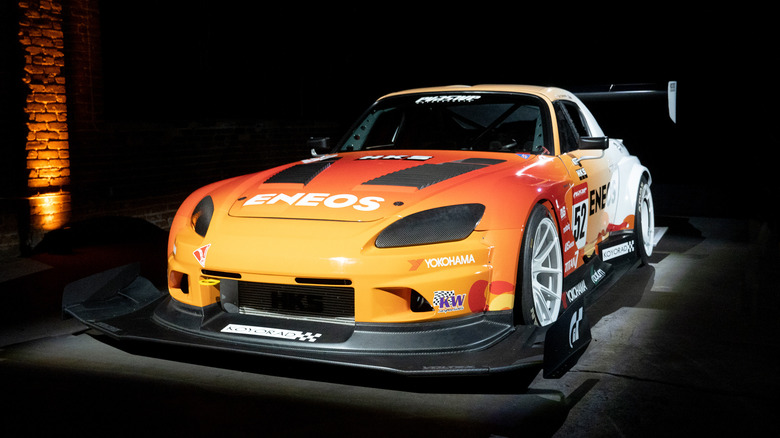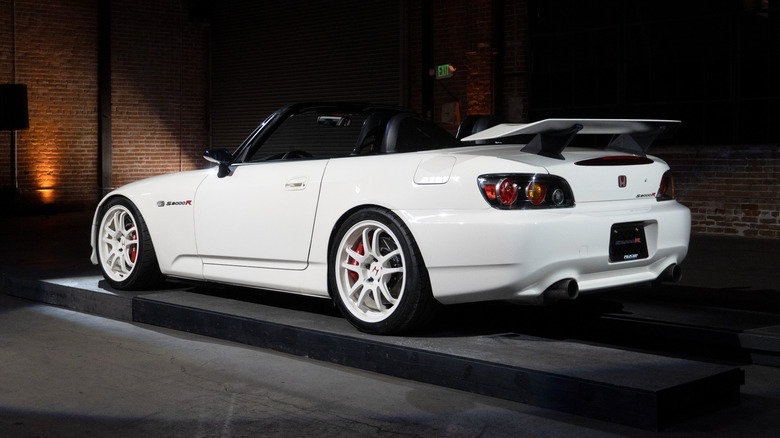Up Close With Evasive Motorsports' S2000R Restomod And Its Wild Civic Type R Heart
At a media event in Downtown Los Angeles this month, Evasive Motorsports unveiled a duo of incredible projects based upon the classic Honda S2000. The first, dubbed the "S2000R," reimagines a nimble road-legal sports car as if Honda ever built a Type R variant for the S2000 platform, with a modern turbocharged engine and literally all the performance goodies to go along with an OEM-style bodykit and interior upgrades. The second takes the S2000R's performance to altogether new heights—literally, by bolting on a massive aero package, dropping in a 650-horsepower engine swap, and gutting the interior as prep for an attempt at the Pikes Peak International Hill Climb in June 2023.
Evasive Motorsports first made a name in the aftermarket industry selling parts for Japanese tuner cars back in 2002. Last year, the company celebrated two decades of business but also an EV class win at Pikes Peak with an aero-focused Tesla Model 3 driven by drift-champion-turned-racing-driver Dai Yoshihara. But before the Tesla project, Evasive raced both a Toyota-Scion GT86 and S2000 at the epic fourteener hillclimb. At Auto Conduct in DTLA, Evasive CEO Mike Chang walked me through everything his team learned over 20-plus years of aftermarket tuning and racing that now goes on full display for the new S2000R and S2000RS.
Falling in love with the original Honda S2000
I first visited with Chang last year to check out the Model 3 after it returned to Evasive's Cerritos shop following the win at Pikes Peak. Even then, he hinted at the forthcoming S2000R, which he envisioned as a JDM-style restomod with Singer-level build quality. But the project was always about more than just an engine swap and bodykit, instead Chang wanted to retain the original driving dynamics of a car he learned to love years ago, in the early 2000s—and that, in classic gearhead fashion, he always regrets selling.
"I still reminisce about the days when I had an S2000, which I fell in love with," he remembers. "It's just that special feeling I want to recreate."
Essentially, the Evasive vision of an S2000 Type R doubles down on those decades-old feelings. An iconic paintjob in Championship White matched four other OEM Type R cars on display at Auto Conduct for the debut: an FK8-gen Civic, a pair of right-hand-drive JDM Integras, and an NSX. In a darkened room with such bright paint, the first things everybody on hand noticed were the massive wing, stunning EVS Tuning 52R wheels, and interior details from Recaro Podium carbon bucket seats to Alcantara used just about everywhere. Up close and personal, I kept glancing back at the overall profile—even up on ramps, the car looked tiny, but different.
"The whole front end has been widened," Chang told me, when I asked about the proportions. "Only about 30 millimeters, but you can't tell just by looking at it. Everything's been worked over, it just looks like a factory type of finish."
New touches on a late-model classic
Chang did caution me that the car on display is just a prototype, which will serve as test bed for further refinement before Evasive begins selling the car to the general public hopefully later this year, so I bit my tongue about a few panel gaps that looked wonky to my obsessive eye. The nose gets a 20th Anniversary Edition front bumper, those aero mirrors come courtesy of Spoon, a carbon fiber tonneau cover tops the lowered convertible roof, and carbon fiber pieces replace the hood and trunk lid.
To a certain extent, the new-old-stock interior bits so typical of late-90s engineering seemed, for me at least, to clash with the carbon pieces and smooth Alcantara. But that's probably part of the nostalgia factor that Evasive wants to evoke for potential customers, along with the good-old-fashioned manual transmission that there was no question about not carrying over.
Stick shift required
That stick shift allows for more precise connection to the star of this S2000 show: a turbocharged K20C1 four-banger borrowed from an FK8 Civic Type R. With a MoTeC ECU, titanium exhaust, and upgrades to the intake manifold, downpipes, oil cooler, and radiator, the already peppy powerplant now puts down a dyno-proven 300 horsepower at the rear wheels.
Anything under 1,000 horsepower might sound underwhelming in the current restomod era, but Chang repeatedly reminded me that where the original S2000 always seemed somewhat gutless at lower RPMs, the low-end torque of a modern turbo engine essentially doubles the car's original output. That changes the game—even if while losing some of the high-revving VTEC appeal of the original F20C's screaming redlines.
"This is gonna be obviously a lot lower than 9,000 or 8,000 RPM," Chang admitted. "It's like 7,000 and change. But I think you'll forget about that once you realize you don't have to downshift two gears just to pass somebody on the freeway."
Fast and furious, but not scary
Just look at that carbon airbox and turbo—all assembled with a bit of flair compared to a stock engine bay, but with impressive fit and finish, to say the least. I asked Chang how fast, really, the S2000R feels.
"Our intention was to never make it scary," he laughed, "so it's fast but not scary. It's fast enough where you can drive it eight or nine-tenths and not worry about your life."
"Actually, it's an accomplishment to get it to that point," he added, "Because I think what people don't understand is there's a plenty of fast cars out there, but how much of them can you actually use in a real life situation? You know, most cars, that's not problem. Most cars are too fast."
All-out straight-line speed never fit into the S2000's personality from the get-go, despite the F20C's status as highest specific-output naturally aspirated engine in the world at the time. What Honda nailed, rather, was the unified combination of impeccable handling and immaculate controls, from the chassis' perfectly neutral weight distribution to the buttery shift action of the manual gear selector. Chang believes that Evasive's extensive and personal experience with the platform makes the S2000R's many upgrades come together a bit of Goldilocks perfection—not too much and not too little.
Driving dynamics go far beyond a big power upgrade
"We've been tinkering and just working on these S2000s for almost 20 years now," he told me. "And I think we know what it takes to not overdo things. So we've worked over the suspension, we adjust a lot of settings in the car, but we never do it too much in a way where it doesn't feel like an S2000 anymore. And I think our goal was never to reinvent the S2000, but it's to make it the ultimate S2000."
Supporting the power upgrades, Evasive installed an OS Giken limited-slip diff within a high-capacity differential housing and an in-house custom bellhousing adapter plate. The noticeably lowered suspension employs KW Clubsport coilovers, track-tested bushings, a bump steer kit and camber joints from EVS Tuning, and Eibach front and rear sway bars. Brembo six-pot front and four-pot rear brakes should more than manage to rein in the power increase on track or in the canyons. Those forged wheels, meanwhile, look big but actually measure a relatively restrained 18x9 inches, with 255-millimeter Yokohama AD09 tires.
A racecar lurking in the shadows
The whole time Chang and I checked out the S2000R, the Pikes Peak car hulked under a big sheet in a dark corner behind us. I asked point-blank whether customers in the market for the road car might want some of the more potent performance that Evasive crams into the racer. But Chang quickly put his foot down on that idea.
"It's not possible, no way," he said, pointing at the racecar, "This is the extreme, this is literally to demonstrate what we can do as a shop, our know-how. I will almost say the S2000R is actually more difficult because we have to think about creature of comfort. We have to think about how it feels on the LA streets, with the potholes and all that stuff."
Racecars make no such concessions to driver comfort. "Dai's gonna be miserable," I joked. "For like nine minutes."
"Who cares about that," Chang replied, laughing again. "He'll deal with it."
Before fully focusing on the Pikes Peak S2000RS, I asked Chang the most important question, which the Evasive press release and online teasers left conspicuously unanswered.
"As far as pricing," he replied, "It's not set yet just because this is still in the prototype phase and I don't want to come out with the price until we're sure that this is perfection in our eyes. Then we offer it to the public."
Unveiling the Evasive Motorsports S2000RS
As much as the public needs to know how much an S2000 restomod might cost, we also needed to know more about Evasive's vision for a fully prepped Pikes Peak car. Finally, as the day turned to night and Auto Conduct's skylights dimmed, Chang and Yoshihara signaled to pull back the sheet—quite an effort, since the rear wing stands almost at my shoulder height. Like any Pikes Peak racecar, the S2000RS gets totally stripped and gutted, with an aero package that makes F1 cars look tame.
Exposed carbon fiber that looked about three-quarters of an inch think made up the front splitter with Voltex Racing Suzuka Japan badging. Similar pieces made up the extensive side skirts and wider-than-wide rear diffuser, even the blanked headlights and hood heat extractors. A brilliant paint job nearly masks the Mugen hardtop (also carbon, of course) and 18-inch Titan 7 T-P5 race wheels measure a whopping 11 inches wide and come shod in 280-millimeter Yokohama A005 slicks. The wholly radical setup looks primed straight from Evasive's history in time attack, in addition to past Pikes Peak entries.
"What you see today is literally everything we've got into making the car go as fast as possible," Chang explained. "But the key thing is we're still trying to maintain that balance even though it's such an extreme level. We want to make sure not to overdo one thing over another, so it's just enough power, just enough aero, just enough grip front-to-back. The ratio has gotta be just perfect."
Balancing power, aerodynamics, and reliability
Last year, Chang revealed just how much power loss the Model 3 suffered due to battery temperatures, despite extensive efforts to improve airflow and modulate output early in the race. For a gasoline-powered car, the reduced oxygen at the top of Pikes Peak presents more of a challenge. I asked how Evasive attempts to combat those power losses.
"The most important thing is to finish the race," Chang admitted. "Obviously, all internal combustion engine cars will lose a lot of power as you get higher in elevation. So we have certain safety measures in place where we make sure the turbo doesn't overspin, we make sure the temperatures are in check, even if we're down, let's just say half the horsepower. I think it has enough pace in the bottom half of Pike's Peak, so it will still be a very fast run. And we just gotta make sure that it's reliable on the upper section."
That focus on reliability probably explains why the S2000RS stats on paper also sound a bit lower than expected. The F20 inline-four gets stroked to 2.4 liters with chromoly connecting rods and bearings, uprated springs in the cylinder head, and a 99-millimeter balanced crankshaft, plus an HKS GT6290 ball-bearing turbo bolted on for good measure. And yet, Evasive claims the powerplant puts down "only" 650 horsepower at the wheels, significantly less than the GT86 the team raced before the Tesla.
A perfect tool for Dai Yoshihara
A seven-speed sequential gearbox from OS Giken sends that power rearward, with a Holinger pneumatic shifter upgrade and then an IP 8.8 diff kit with OS Giken LSD internals. Again, KW dampers and upgraded brakes make an appearance. All told, the S2000RS weighs less than the GT86, but more than I expected at 2,400 pounds. Then again, all the aero components still require enough bracing to actually transfer so much downforce to the chassis and, eventually, the tires.
Even carbon fiber weight savings can only go so far. Still, as I walked around and peeked my head into the cockpit, I couldn't really think of any way to take an S2000 and make it any more hardcore. With Yoshihara behind the wheel, the sight of such a radical racecar sprinting up the hill at Pikes Peak will probably only be matched by the screaming turbo and rifle-crack shifts of the Holinger air shifter. But how fast can a car like this actually go?
"In 2020, we won the unlimited class, but our time was ten minutes and five seconds," Yoshihara said, remembering the GT86. "This year, what I wanted to achieve personally was, I want to get a sub-ten."
The public debut of both the S2000R and S2000RS also marked Yoshihara's first time with either, too.
"This is my first time actually seeing this car," he said. "This car has 650 horsepower, but it's actually a lot lighter. This one has ABS, TC, better aero, so... I don't see why we can not go sub-ten with this."
The waiting game begins
Of course, the unexpected always comes into play at Pikes Peak. Last year's unseasonable fog and rain probably helped Yoshihara log such a competitive time in a relatively heavy EV thanks to the additional grip of all-wheel drive in the slip and slide. Only the crucible of race day can reveal whether Evasive built the right car, even if it looks (and presumably sounds) the business amid the shadows of Auto Conduct.
After Pikes Peak, Evasive will continue developing the S2000R, too. Registration here in California remains an outstanding question—even with a CARB-legal Civic Type R engine and if the full evap system and gas tank can fit on the S2000 chassis, the tuning and upgrades probably mean the car can't pass smog testing. Maybe a low-volume manufacturer status or SB100 exemption can fit into the plan.
The mystery of pricing will also fit into any potential sales success for Evasive, given that mass-production amortizing doesn't really apply to a project like this. A Singer-level ask is probably out of the question, even if older millennials with discretionary income want to live out their JDM dreams. Regardless, for those who grew up amid the JDM craze piqued by The Fast and the Furious, the S2000R from Evasive Motorsports probably fills a fun gap in Honda history unlike any other.
